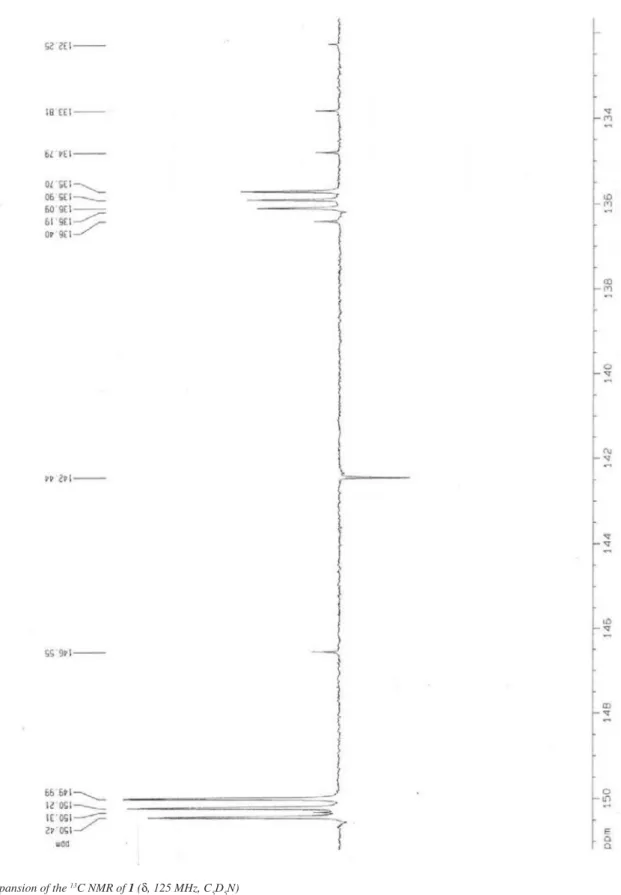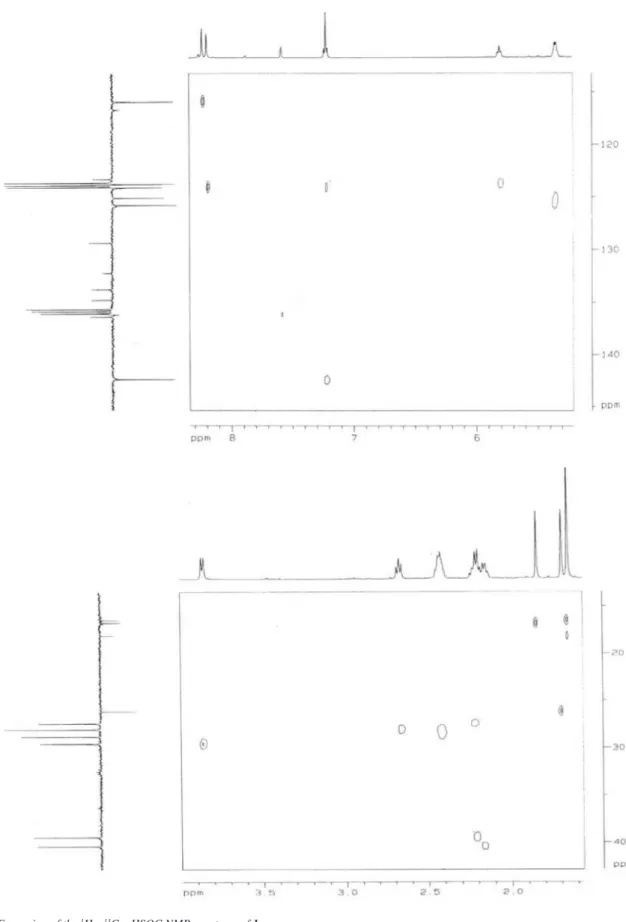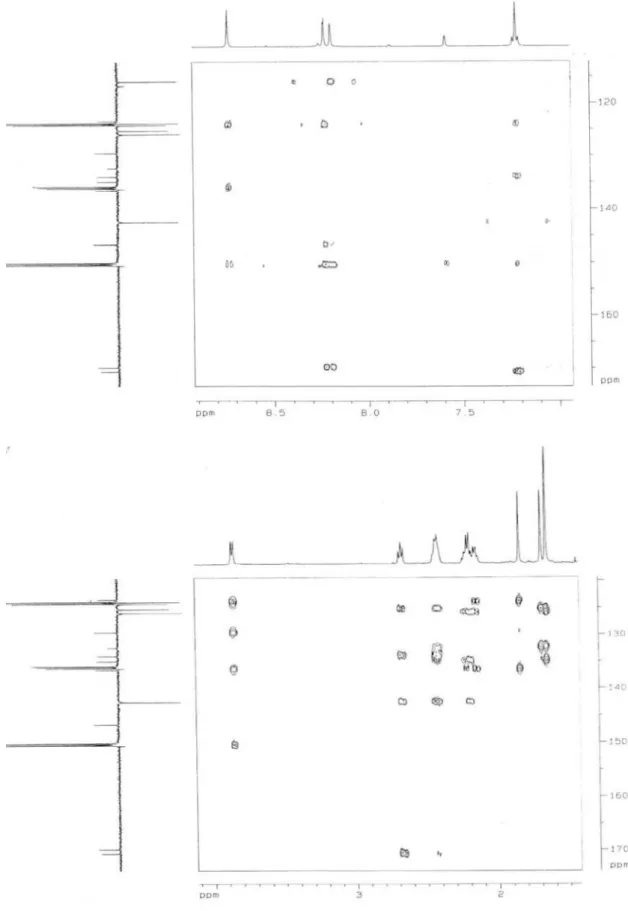Artigo
*e-mail: cchaves@ltf.ufpb.br
CALDENSINIC ACID, A BENZOIC ACID DERIVATIVE AND OTHERS COMPOUNDS FROM Piper carniconnectivum
Harley da Silva Alves, Maria de Fátima Vanderlei de Souza e Maria Célia de Oliveira Chaves*
Laboratório de Tecnologia Farmacêutica, Universidade Federal da Paraíba, CP 5009, 58051-970 João Pessoa - PB, Brasil
Recebido em 20/4/09; aceito em 8/12/09; publicado na web em 24/3/10
A benzoic acid derivative – caldensinic acid; E-phytyl hexadecanoate; β-sitosterol and stigmasterol mixture and phaeophytin a were isolated from the aerial parts of Piper carniconnectivum. The structures of these compounds were established unambiguously by IR, MS, 1D and 2D NMR analysis.
Keywords: 3,4-dihydroxy-5-(11’-carboxyl-3’,7’,15’-trimethylhexadeca-2’E, 6’E, 10’E, 14-tetraenyl) benzoic acid; E-phytyl hexadecanoate; phaeophytin a.
INTRODUCTION
During our search on the chemistry of Brazilian North-Northeast Piperaceae species we have isolated some amides,1 lavonoids,2 aristolactams,3 propenylphenols,4 terpenes,4 phenylalkanoids4 and benzoic acid derivative.4 In this paper, we report the isolation of 3,4-dihydroxy-5-(11’-carboxyl-3’,7’,15’-trimethylhexadeca-2’E, 6’E, 10’E, 14-tetraenyl) benzoic acid; E-phytyl hexadecanoate, pha-eophytin a, β-sitosterol and stigmasterol mixture from whole aerial parts of Piper carniconnectivum C. DC. (Piperaceae), known by the vernacular name “pimenta-longa”, species native to the Amazon region, North of Brazil.5 A lavonoid (galangin), a phenone (2-me-thoxy-4,5-methylenedioxypropiophenone), a coumarin (xanthyletin), three natural cyclopentenedione derivatives and four lavonoids: 5-hydroxy-7-methoxy-6-methyllavanone, 5-hydroxy-7-methoxy-8-methyllavanone, 5-hydroxy-7-methoxy-6,8-dimethyllavanone and 2’-hydroxy-4’,6’-dimethoxy-3’,5’-dimethylchalcone have recently been reported from this plant.6
RESULTS AND DISCUSSION
The mass spectrum of the compound 1 (Figure 1)showed a molecular ion peak at m/z 455,12 (M-H)-corresponding to C27H36O6 and its IR spectrum showed a carbonyl absorption (1686 cm-1) as well as a broad hydroxyl absorption (3438 cm-1) typical of a carboxylic acid. The aromatic part of the 1H NMR spectrum exhibited only two signals: δH 8.23, (d, J = 1.7 Hz, 1H) and δH 8.19 (d, J = 1.7 Hz, 1H) with chemical shifts and splitting pattern consistent with protons in meta position and suggested the presence of H-2 and H-6 of a 3,4,5-substituted benzoic acid unit. Furthermore, the 1H NMR spec-trum revealed the presence of a benzylic methylene resonance at δH 3.85 (d, J = 7.2 Hz, 2H), three signals: δH 5.81 (t, J = 7.2 Hz, 1H), δH 5.34 (brq, J = 5.5 Hz, 2H) and δH 7.21 (t, J = 7.3 Hz, 1H) to four olein protons, four signals: δH 2.67 (brt, J = 7.7 Hz, 2H), δH 2.44-2.40 (m, 4H), δH 2.20 (m, 4H), δH 2.15 (m, 2H) to six methylene groups and three resonances [δH1.84 (s, 3H), δH1.69 (s, 3H) and δH 1.65 (s, 6H)] to four methyl substituents.
The 1H NMR data associated with the presence of six signals to methylene carbons, four to methyl carbons, six to methyne car-bons and ten to quaternary carcar-bons in the APT spectrum (Table 1), beyond of the cross peaks in the HMBC spectrum, for the signal at δC 170.7 (carbonyl carbon) with δH 7.21 (olein hydrogen 10’)
and δH 2.67 (methylene hydrogen 12’), provided evidence for the presence of a 3’,7’,15’-trimethylhexadeca 2’,6’,10’,14’-tetraenyl -11’-carboxyl group in the benzoyl unit. The cross peaks for the signals at δC 29.5 (C-1’) and δC 8.19 (H-2) in the HMBC spectrum supported the evidence for the presence of the hexadecane group at C-3, orto to the methyne proton (δH8.19) and suggested the signal at δH 8.23 to H-6 and, consequently, two hydroxyl groups to C-4 and C-5 in benzoyl unit. The geometry of the double bonds at C-2’, C-6’ and C-10’ were suggested by the 1H x 1H - NOESY spectrum, in which H-2’ (δH 5.81) showed cross peak with H-4’ (δH 2.15) conirming E coniguration of the double bond at C-2’; the lack of correlation at H-6’ (δH 5.34) with Me-18’ (δH 1.65) and the presence of cross peaks between Me-18’ (δH 1.65) with H-9’ (δH2.44-2.40) and H-5’ (δH2.20) supported E geometry at C-6’; inally the H-10’ (δH 7.21) only showed cross peak with H-9’ (δH 2.44-2.40) and H-8’ (δH 2.20) suggesting E geometry at C-10’ 7 (Figure 2). All the assignment of carbons and protons were inferred by interpretation of the spectral data: 1H (1D and 2D: 1H x 1H-COSY, 1H x 1H-NOESY) and 1H x 13C-COSY. nJ
CH (n=1, HMQC; n=2 and 3, HMBC) Table 1. All these data, summarily described in the Table 1, compared with the literature,7 supported the evidence of: 3,4-dihydroxy-5-(11’-carboxyl-3’,7’,15’-trimethylhexadeca-2’E, 6’E, 10’E, 14-tetraenyl) benzoic acid to 1, previously isolated only from Piper caldense.
On the basis of the above spectroscopic data and comparison with the literature,82 was assigned as E-phytyl hexadecanoate related in the family Piperaceae for the irst time.
The 1H NMR spectrum of 3 (Figure 1) showed the presence of three sp2 methyl singlets at δ
H 3.17, 3.37 and 3.66, a vinyl group at δH 7.96 (m, 1H), δH 6.27 (m, 1H), δH 6.14 (m, 1H) and three olein hydrogens at δH 9.46 (s, 1H), δH 9.31 (s, 1H) and δH 8.53 (s, 1H) which are related to the hydrogens 5, 10 and 20 of the porphyrin skeleton of phaeophytin.9-11 This data and the presence of an enve-lope of signals in the aliphatic region of the 1H NMR spectrum of 3 and the resonance found to C-173 (δ
Caldensinic acid, a benzoic acid derivative and others compounds 803 Vol. 33, No. 4
EXPERIMENTAL
General experimental procedures
IR spectra were obtained on a Perkin-Elmer FT-IR 1750 spectrophotometer in KBr disks and [M-H]- was obtained on HPLC-MS-MS analysis. A Shimadzu HPLC system coupled to a Quattro LC mass spectrometer (Watter, Manchester-UK) equipped with a Z-spray ESI source and operated in negative mode was used. Chromatographic separation was achieved on Shimadzu Shimpack C-18 column (4,6 x250 mm x 5 µm). Mobile phase was 0,1% aqueous formic acid and acetonitrile (15:85 v/v). The low rate was set 1mL/min. and 20 µL of sample was injected into the column at 40 °C. The electrospray source was operated in the negative mode. The capillary potential was set a 2.5 kV, desolva-tion temperature 250 °C. Source temperature 110 °C, desolvadesolva-tion gas low 250 L/h. Mass spectra was acquired in full scan mode (m/z 100-800 uma). `H NMR, 13C NMR and 2DNMR spectra were recorded on Bruker 500 and Mercury-Varian 200 spectrometers in pyridine-d5 and CDCl3 at 27 °C. Chromatography column (CC)
was carried out on Sephadex LH-20 (Sigma) and silica gel 60 for analytical TLC (PF PF254, Art. 7749, Merck).
Extraction and isolation
The plant was collected in the Garden of Emilio Goeldi Museum in Belém-PA, where a voucher specimen is deposited under the number MSP-009. The powdered material of Piper carniconnectivum (1300 g) was exhaustively extracted with 95% EtOH (4x2.0L) and provided 105 g of crude extract (8,0%). The extract was concentrated under red. Pres. and partitioned with hexane, CHCl3, EtOAc. The hexane layer (12,5 g) was concentrated and chromatographed on a silica gel column, using hexane, hexane/CHCl3, CHCl3 and CHCl3/ MeOH as eluents resulting in 101 fractions (250 mL). Fractions were monitored by TLC and similar fractions were combined. The fraction 36-40, eluted in hexane/CHCl3 (1:1), was chromatographed on silica gel column with gradient mixtures of hexane/CHCl3 yielding 9 fractions (20 mL). Fraction 3, eluted in hexane afforded 2 (12 mg). The fraction 55-59, eluted in CHCl3/hexane (7:3), subjected on silica gel column, using as eluents hexane, CHCl3, EtOAc and MeOH in gradient mixture, provided 18 fractions (50 mL), which were reduced to 7 groups after TLC. Group 3 eluted in CHCl3/hexane (7:3), after Figure 1. Compounds isolated of Piper carniconnectivum C.DC (1)and (3)
Figure 2. NOE correlations of 1 Table 1.1H (500MHz) and 13C (125MHz) NMR spectral data of 1, including
heteronuclear 2D shift-correlated obtained by 1H-13C-COSY-nJ
CH (n=1, HMQC; n=2 and 3, HMBC) experiments, in pyridine-d5, as solvent. δ (ppm) and J ( Hz)
1H-13C-COSY-1J
CH
1H-13C-COSY-nJ CH δC δH
2J CH 3J CH C 1 123.3
3 129.4 2H-1’
4 150.3 H-2, H-6, 2H-1’
5 146.6 H-6
7 169.9 H-2, H-6
3’ 136.4 2H-1’, 2H-4’,
Me-17’
2H-5’
7’ 134.8 2H-8’, Me-18’ 2H-5’, 2H-9’
11’ 133.8 H-10’, 2H-12’ 2H-13’, 2H-9’
15’ 132.3 Me-16’, Me-20’ 2H-13’
19’ 170.7 H-10’, 2H-12’
CH
2 124.1 8.19 (d, J=1,7 Hz, 1H) H-6 6 115.9 8.23 (d, J=1,7 Hz, 1H) H-2 2’ 123.8 5.81 (t, J=7,2Hz, 1H) 2H-1’ 2H-4’, Me-17’ 6’ 125.8 5.34 (brq, J=5,5 Hz, 2H) 2H-5’ 2H-4’, 2H-8’, Me-18’ 10’ 142.4 7.21 (t, J=7,3 Hz, 1H) 2H-9’ 2H-8’, 2H-12’ 14’ 125.1 5.34 (brq, J=5,5 Hz, 2H) 2H-13’ 2H-12’, Me-16’,
Me-20’ CH2
1’ 29.5 3.85 (d, J=7,2Hz, 2H) H-2’ H-2
4’ 40.4 2.15 (m, 2H) 2H-5’ H-2’, CH-17’
5’ 27.4 2.20 (m, 4H) 2H-4’, H-6’
8’ 39.4 2.20 (m, 4H) 2H-9’ H-6’, H-10’, CH-18’ 9’ 28.8 2.44-2.40 (m, 4H) 2H-12’
12’ 28.1 2.67 (brt, J=7,7 Hz, 2H) 2H-13’ H-10’ 13’ 28.1 2.44-2.40 (m, 4H) 2H-8’
CH3
16’ 26.2 1.69 (s, 3H) CH-20’
17’ 16.7 1.84 (s, 3H) H-2’, 2H-4’
18’ 16.4 1.65 (s, 6H) H-6’, 2H-8’
20’ 18.1 1.65 (s, 6H) CH-16’
successive preparative TLC with CHCl3/hexane (8:2) afforded 4 (30 mg) and group 5 eluted in CHCl3, submitted to preparative TLC with CHCl3-MeOH (99:1), provided 3 (26 mg).
The CHCl3 layer (11,0 g) was concentrated and chromatogra-phed on Sephadex LH-20 colunm, eluted with MeOH afforded 152 fractions (10 mL) and similar fractions were combined after TLC. Fraction 9-12 was subjected to a new Sephadex LH-20 column eluted with MeOH:CHCl3 (1:1) yield 23 fractions (25 mL). Fraction 6 (15.0 mg) afforded 1.
The structures of 1, 2, 3 and 4 were elucidated as 3,4-dihydroxy-5-(11’-carboxyl-3’,7’,15’-trimethylhexadeca-2’E, 6’E, 10’E, 14-tet-raenyl) benzoic acid; E-phytyl hexadecanoate, phaeophytin a and a β-sitosterol and stigmasterol mixture, respectively by interpretation of the spectral data (1D and 2D NMR, IV and MS).
3,4-Dihydroxy-5-(11’-carboxyl-3’,7’,15’-trimethylhexadeca-2’E, 6’E, 10’E, 14’-tetraenyl) benzoic acid (1)
Brown gummy solid. λ max. (KBr, cm-1): 3438, 2921, 2855, 2560, 1686, 1599, 1548, 1513, 1443, 1382, 1300, 1215, 989, 893, 774.MS 455,12 [M-H]P-. 1H and 13C NMR spectral data (Table 1).
1H and 13C NMR and IR spectral data of E-phytyl hexadecanoate (2), Phaeophytin a (3) and β-sitosterol and stigmasterol (4) were compared with literature data.8-19
SUPPLEMENTARY MATERIAL
Available in http://quimicanova.sbq.org.br, in PDF ile, with free access.
ACKNOWLEDGMENTS
The authors thank CNPq for inancial support, D. Esdras and E. R. S. from Universidade Federal do Ceará for the NMR spectra, M. das G. B. Zoghbi from Emilio Goeldi Museum for the plant material and A. C. de A. Tomaz for the English correction.
REFERENCES
1. Araújo-Júnior, J. X.; Da-Cunha, E. V. L.; Chaves, M. C. de O.; Gray, A. I.; Phytochemistry1997, 44, 559; Santos, B. V. O.; Chaves, M. C. de O.; Biochem. Syst. Ecol. 1999, 27, 113; Cunha, E. V. L.; Chaves, M. C. de O.; Fitoterapia2001, 72, 197; Chaves, M. C. de O.; Santos, B. V. O.; Oliveira, A. H.; Biochem. Syst. Ecol. 2003, 31, 1213; Chaves, M. C. de O.; Figueredo-Júnior, A. G.; Santos, B. V. de O.; Fitoterapia2003, 74, 181.
2. Chaves, M. C.de O.; Zoghbi, M. G.; Oliveira, G. E.; Alves, H. S.; Braz. J. Pharmacogn. 2010, in press.
3. Araújo-Júnior, J. X.; Chaves, M. C. de O.; Da-Cunha, E. V. L.; Gray, A. I.; Biochem. Syst. Ecol. 1999, 27, 325; Cardozo-Júnior, E. L.; Chaves, M. C. de O.; Pharmaceutical Biology2003, 41, 216; Chaves, M. C. de O.; Oliveira, A. H.; Santos, B. V. O.; Biochem. Syst. Ecol. 2006, 34, 75. 4. Santos, B. V. O.; Da-Cunha, E. V. L.; Chaves, M. C. de O.; Gray, A. I.;
Biochem. Sist. Ecol. 1997, 25, 471; Santos, B. V. O.; Da Cunha. E. V. L.; Chaves, M. C. de O.; Gray, A. I.; Phytochemistry1998, 49, 1384; Santos, B. V. O.; Chaves, M. C. de O.; Biochem. Sist. Ecol. 1999, 27, 539; Santos, B. V. O.; Chaves, M.C . de O.; Acta Farm. Bonaerense2000, 19, 45; Chaves, M. C. de O.; Santos, B. V. O.; Fitoterapia2002, 73, 547. 5. Yuncker, T. G.; Hoehnea 2 1972, 19, 366.
6. Facundo, V. A.; Sá, A. L.; Silva, S. A. F.; Morais, S. M.; Matos, C. R. R.; Braz-Filho, R.; J. Braz. Chem. Soc. 2003, 15, 140; Facundo, V. A.; Braz-Filho, R.; Biochem. Syst. Ecol. 2004, 32, 1215.
7. Freitas, G. C.; Kitamura, R. O. S.; Lago, J. H. G.; Young, M. C. M.; Guimarães, E. G.; Kato, M. J.; Phytochem. Lett.2009, 2, 119. 8. Pereira-Júnior, O. L.; Wolter Filho, W.; Rocha, A. F. I.; de Carvalho, M.
G.; Braz Filho, R.; Quim. Nova1990, 13, 247.
9. Matsuo, A.; Ono, K.; Hamasaki, K.; Nozaki, H.; Phytochemistry1996, 42, 427.
10. Duan, H.; Takaish, Y.; Momota, H.; Ohmoto, Y.; Taki, T.; Phytochemistry 2002, 59, 85.
11. Silva, T. M. S.; Lins, A. C. S.; da Costa, D. A.; Cavalcante, J. M. S.; Matias, W. N.; Souza, M. F. V.; Quim. Nova 2006,29, 1250.
12. Schwikkard, S. L.; Mulholland, D. A.; Hutchings, A.; Phytochemistry 1998, 49, 2391.
13. Ohshima, M. H.; Oda, T. A.; Shiratsuchi, S. M.; Chem. Pharm. Bull., 1994, 42, 2174.
14. Silva, T. M. S; Camara, C. A.; Medeiros, F. D.; Oliveira, E. J.; Agra, M. F.; Harley, R. M.; Giulietti, A. M.; Biochem. Syst. Ecol.2006, 34, 263. 15. Buchanan, M. S.; Hashimoto, T.; Asakawa, Y.; Phytochemistry1996, 41,
1373.
16. Porra, R. J.; Schafer, W.; Cmiel, E.; Scheer, H.; FEBS J. 1993, 323, 31. 17. Dias, B. B.; Castilho, G.; Leite, M. L.; Resumos do VII Encontro de
Pesquisa da Universidade Estadual de Ponta Grossa. Ponta Grossa, Brasil, 2007.
18. Tomaz, A. C. A.; Nogueira, R. B. S. S.; Pinto, D. S.; Agra, M. F.; Souza, M. F. V.; Da-Cunha, E. V. L.; Rev. Bras. Farmacog. 2008, 18, 47. 19. Kojima, H.; Sato, N.; Hatano, A.; Ogura, H.; Phytochemistry1990, 29,
Quim. Nova, Vol. 33, No. 4, S1-S12, 2010
Material Suplementar
*e-mail: cchaves@ltf.ufpb.br
CALDENSINIC ACID, A BENZOIC ACID DERIVATIVE AND OTHERS COMPOUNDS FROM Piper carniconnectivum
Harley da Silva Alves, Maria de Fátima Vanderlei de Souza e Maria Célia de Oliveira Chaves*
Laboratório de Tecnologia Farmacêutica, Universidade Federal da Paraíba, CP 5009, 58051-970 João Pessoa - PB, Brasil
Figure 1S. IR spectrum (λ
Caldensinic acid, a benzoic acid derivative and others compounds 3
Vol. 33, No. 4
Caldensinic acid, a benzoic acid derivative and others compounds 5
Vol. 33, No. 4
Caldensinic acid, a benzoic acid derivative and others compounds 7
Vol. 33, No. 4
Caldensinic acid, a benzoic acid derivative and others compounds 9
Vol. 33, No. 4
Caldensinic acid, a benzoic acid derivative and others compounds 11
Vol. 33, No. 4









